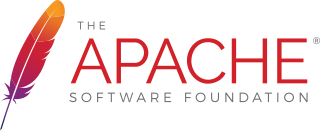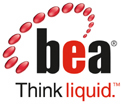Related Research Articles

The Apache Software Foundation is an American nonprofit corporation to support a number of open-source software projects. The ASF was formed from a group of developers of the Apache HTTP Server, and incorporated on March 25, 1999. As of 2021, it includes approximately 1000 members.
Project management is the process of leading the work of a team to achieve all project goals within the given constraints. This information is usually described in project documentation, created at the beginning of the development process. The primary constraints are scope, time, and budget. The secondary challenge is to optimize the allocation of necessary inputs and apply them to meet pre-defined objectives.
Zope is a family of free and open-source web application servers written in Python, and their associated online community. Zope stands for "Z Object Publishing Environment", and was the first system using the now common object publishing methodology for the Web. Zope has been called a Python killer app, an application that helped put Python in the spotlight.

BEA Systems, Inc. was a company that specialized in enterprise infrastructure software products, which was wholly acquired by Oracle Corporation on April 29, 2008.
An application program is a computer program designed to carry out a specific task other than one relating to the operation of the computer itself, typically to be used by end-users. Word processors, media players, and accounting software are examples. The collective noun "application software" refers to all applications collectively. The other principal classifications of software are system software, relating to the operation of the computer, and utility software ("utilities").

In systems engineering, information systems and software engineering, the systems development life cycle (SDLC), also referred to as the application development life cycle, is a process for planning, creating, testing, and deploying an information system. The SDLC concept applies to a range of hardware and software configurations, as a system can be composed of hardware only, software only, or a combination of both. There are usually six stages in this cycle: requirement analysis, design, development and testing, implementation, documentation, and evaluation.
Microsoft Servers is a discontinued brand that encompasses Microsoft software products for server computers. This includes the Windows Server editions of the Microsoft Windows operating system, as well as products targeted at the wider business market. Microsoft has since replaced this brand with Microsoft Azure, Microsoft 365 and Windows 365.
Open-source software development (OSSD) is the process by which open-source software, or similar software whose source code is publicly available, is developed by an open-source software project. These are software products available with its source code under an open-source license to study, change, and improve its design. Examples of some popular open-source software products are Mozilla Firefox, Google Chromium, Android, LibreOffice and the VLC media player.
Graphic design careers include creative director, art director, art production manager, brand identity developer, illustrator and layout artist.
Application lifecycle management (ALM) is the product lifecycle management of computer programs. It encompasses requirements management, software architecture, computer programming, software testing, software maintenance, change management, continuous integration, project management, and release management.
A data steward is an oversight or data governance role within an organization, and is responsible for ensuring the quality and fitness for purpose of the organization's data assets, including the metadata for those data assets. A data steward may share some responsibilities with a data custodian, such as the awareness, accessibility, release, appropriate use, security and management of data. A data steward would also participate in the development and implementation of data assets. A data steward may seek to improve the quality and fitness for purpose of other data assets their organization depends upon but is not responsible for.

Semantic HTML is the use of HTML markup to reinforce the semantics, or meaning, of the information in web pages and web applications rather than merely to define its presentation or look. Semantic HTML is processed by traditional web browsers as well as by many other user agents. CSS is used to suggest its presentation to human users.

Accounting software is a computer program that maintains account books on computers, including recording transactions and account balances. It may depend on virtual thinking. Depending on the purpose, the software can manage budgets, perform accounting tasks for multiple currencies, perform payroll and customer relationship management, and prepare financial reporting. Work to have accounting functions be implemented on computers goes back to the earliest days of electronic data processing. Over time, accounting software has revolutionized from supporting basic accounting operations to performing real-time accounting and supporting financial processing and reporting. Cloud accounting software was first introduced in 2011, and it allowed the performance of all accounting functions through the internet.
LiquidPlanner, Inc. is a company that develops online project management software.

Talis Group Ltd. is a software company based in Birmingham, England that develops software for higher education. They were previously involved in development of library management software and a Semantic Web application platform. In 2005 Talis was voted one of the top ICT Employers in the United Kingdom.
A web browser is a software application for retrieving, presenting and traversing information resources on the World Wide Web. It further provides for the capture or input of information which may be returned to the presenting system, then stored or processed as necessary. The method of accessing a particular page or content is achieved by entering its address, known as a Uniform Resource Identifier or URI. This may be a web page, image, video, or other piece of content. Hyperlinks present in resources enable users easily to navigate their browsers to related resources. A web browser can also be defined as an application software or program designed to enable users to access, retrieve and view documents and other resources on the Internet.
Wolf Frameworks is a web application designing and development platform as a service based in India and United States and represented via partners worldwide.
Information and Communications Technology Academy, better known as iAcademy is a private, non-sectarian educational institution in the Philippines. The college offers specialized Senior High School and Undergraduate programs in fields relating to computer science, game development, multimedia arts, animation, and business management.
Collaborative workflow is the convergence of social software with service management (workflow) software. As the definition implies, collaborative workflow is derived from both workflow software and social software such as chat, instant messaging, and document collaboration.
Podio supplies a web-based platform for creating no code solutions and automated workflows. The feature set includes organizing team communication, business processes, data and content in project management workspaces according to project needs.
References
- ↑ Capterra Best Software for Business
- ↑ Christina Warren, Mashable (February, 2010). In Copper, Basecamp has some competition